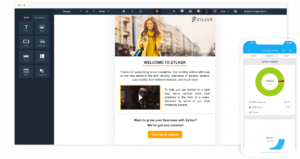What Is Email Marketing?
Email Marketing is one of the most cost-effective marketing methods available to most businesses. At the simplest level, email marketing involves sending a marketing email to everyone on your contact list (Don’t forget about GDPR), but it can become much more powerful as your business grows and you want to become more targeted with your marketing.
Why is Email Marketing so effective?
Most businesses will build their email marketing list from a signup form on their website; this means the subscriber already has some knowledge and interest in what you do as a business. This means that Email Marketing has less work do to that other types of marketing that have to convince the reader even to take a look at your website.

How can I start Email Marketing?
Zoho Campaigns is Zoho’s Email Marketing app. Campaigns comes as part of Zoho One, Zoho CRM Plus or can you can subscribe directly.
Campaigns comes packed with features, but as this is more of just an introduction to Campaigns, I am going to focus on the basics of sending your first campaign.
- Before you can send any campaigns, you need to add some contacts. Contacts can be synced from most Zoho apps or imported from a spreadsheet. Once your contacts are in Campaigns, you can split them into Lists which you can then target separately, for example, one list for Leads and another for Contacts.
- Now we have our contacts list it is essential to make sure you have permission to be emailing them. There are a lot of rules and exceptions within GDPR, but to keep things simple, all you need to do is ensure that every subscriber has explicitly said you can email them. We will have a future blog post going into more detail on GDPR, including the rules around implied permission.
- We now have our email list and know we are acting within the rules of GDPR, so we can now start creating our first campaign. When creating your campaign, you will need to enter all of the information you would for a regular email such as which email address to send the email, from, and what the subject of the email is.
- Designing your email can be as simple or complex as you like. On the simple side, you can choose a premade template and then just add your content, logos, and colours. On the complex side, you can create complete custom HTML emails.
- The final part of your first email campaign will be the sending. You have a couple of options when sending the campaign; you can send it now, schedule it, or send based on time zone. You’ll know which of these works best for you.
To wrap up this blog post, I wanted to share some tips I have on running a successful email marketing campaign:
- Add a Preheader to your email. The Preheader is what shows in the preview text of an email when you view it in a list.
- Try to make it personal by addressing the email to the subscriber’s name.
- Make sure you include your registered business address in the footer of your email; it is a legal requirement.
- Use AB testing to optimize your emails for your audience. This is especially important when you are new to email marketing.
- Create an automated welcome email that is sent to new subscribers. This is a great place to give the subscriber some more information about your business.
- Create a schedule for your emails. Sending too many emails will lead to a high unsubscribe rate.
In the coming weeks, I am going to follow up on this post with some how-tos on using the most sophisticated features within Campaigns
